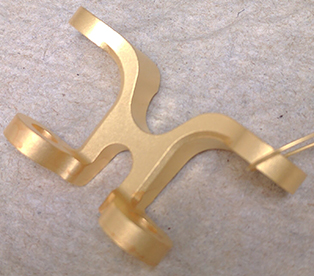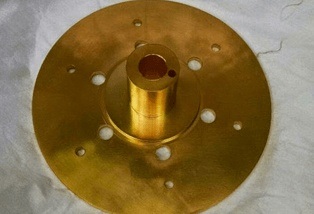Gold is known for its glitter and glamour, but it also has significant value from an electroplating perspective. Why should gold be plated instead of using pure solid gold components or base materials? While plating with gold can be relatively expensive when compared to using less costly materials, this lustrous metal provides a number of important benefits in a wide variety of metal finishing applications. As a rule of thumb, if the additional upfront expense is manageable for your company, gold is usually the best plating option.
Quick Links:
Gold Plating Capabilities | Gold Plating Methods | Gold Plating Specifications | Gold Plating FAQs

Gold Plating Capabilities
- Type I: A, B or C
- Type II: B, C or D
- Type III: A only
- Hard Gold
- Soft Gold
Gold Plating Methods
- Barrel Plating
- Rack Plating
- Vibratory Plating
Gold Plating Specifications
In some instances, it may be necessary to perform gold plating to meet military or engineering specifications.
MIL-DTL-45204D
The MIL-DTL-45204D gold plating spec meets the requirements for the U.S. Department of Defense and its various support agencies and supersedes the previous MIL-G-45204C standard. This spec classifies gold type based on the purity of the material: Type I features a minimum gold content of 99.7 percent, Type II includes 99.0 percent and Type III consists of 99.9 percent. There are also four hardness grades based on the Knoop scale: Grade A (90 max.), Grade B (91-129), Grade C (139-200) and Grade D (201 and over).
Possible combinations for purity vs. hardness are the following:
- Type I: A, B or C
- Type II: B, C or D
- Type III: A only
There are also gold plating thickness standards under this military spec. There are eight classes corresponding to the acceptable minimum thickness:
- Class 00-0.00002
- Class 0-0.00003
- Class 1-0.00005
- Class 2-0.00010
- Class 3-0.00020
- Class 4-0.00030
- Class 5-0.00050
- Class 6-0.00150
Also, there are specific requirements regarding the underplating for the gold coating. Depending on the application and environment, an undercoating of nickel, copper or a Cu/Ni may be used to fulfill the contract requirements. Avoid using a silver or silver/copper underplate unless specifically required. Regardless of the composition of the underplating, it is essential to apply a soft gold strike atop the undercoating before adding the final coating of gold to promote adhesion and reduce the risk of contamination.
ASTM B488 Gold Plating Specification
The ASTM B488 gold plating standard applies to engineering applications. Gold coatings that comply with this spec typically are used to increase the substrate's resistance to corrosion and to prevent tarnishing. The classes and types under this specification mirror those of the MIL-DTL-45204D gold plating standard. However, there are some differences in the thickness requirements. The seven thickness classes under ASTM B488 gold plating include:
- 0.25-0.25 um
- 0.50-0.50 um
- 0.75-0.75 um
- 1.0-1.0 um
- 1.25-1.25 un
- 2.5-2.5 um
- 5-5.0 um
Nickel is the preferred choice for underplating, except for applications requiring a coating thickness of 5.0 um or greater when working with substrates made of copper or a copper alloy. Others reasons that nickel makes the best undercoating material include serving as a brightener for the leveling layer, acting as a corrosion inhibitor in surface pores, preventing tarnish creep on the gold topcoat and acting as a load-bearing underlayer for the contacting surfaces.
The issue of this standard establishes an ASTM Type designation that is new involving purity, which is established for electrodeposited gold:
- Mass percent gold, minimum, excluding potassium, carbon and nitrogen 99.70: New ASTM Type I, MIL-DTL-45204 Type I, Old ASTM Type 2
- Mass percent gold, minimum, excluding potassium, carbon and nitrogen 99.00: New ASTM Type II, MIL-DTL-45204 Type II, Old ASTM Type 3
- Mass percent gold, minimum, excluding potassium, carbon and nitrogen 99.90: New ASTM Type III, MIL-DTL-45204 Type III, Old ASTM Type 1
The hardness values are specified by ASTM Code:
- Knoop Hardness Range 90 HK25 maximum: ASTM Code A
- Knoop Hardness Range 91–129 HK25: ASTM Code B
- Knoop Hardness Range 130–200 HK25: ASTM Code C
- Knoop Hardness Range >200 HK25: ASTM Code D
When it comes to the relationship between purity and hardness for good commercial practice, the following combinations are fully representative:
- New ASTM I - Old ASTM Type 2 - Code A, B and C
- New ASTM II - Old ASTM Type 3 - Code B, C and D
- New ASTM III - Old ASTM 1 - Code A only
Additional Requirements
Examples of other requirements for complying with the MIL-DTL-45204D and the MIL-DTL-45204D gold plating spec include ensuring the base metal is free of surface defects and implementing appropriate pretreatment steps before plating. Avoid electroplating steel parts and components that have a tensile strength of 220,000 psi unless stipulated in the contract. Acceptable post-plating procedures include removing all plating salts from the substrate and inspecting the part for blisters that will render the piece defective.
SPC Is a Gold Electroplating Leader
Over our more than eight decades of service, Sharretts Plating Company has developed a finely honed gold plating process. While we can perform gold plating for a variety of applications, our primary focus is in the electronics industry. In addition to gold electroplating, we also offer a highly effective immersion plating process that does not require the use of electricity. Request Quote
Gold Plating FAQs
What Is Gold Electroplating?
Gold electroplating is a method for placing a thin coating, or layer, of gold onto the surface of another metal object. The gold electroplating process involves electrodeposition, in which an electric current is passed through a liquid electrolyte solution containing dissolved gold ions and other chemicals. This causes the ions to adhere to the surface of the object, resulting in the formation of a protective gold coating.
What are the Benefits of Electroplating With Gold?
Gold contains a number of unique properties that make it ideally suited for numerous plating processes. Plating with gold also offers a host of valuable functional benefits for industrial manufacturers including:
- Preventing corrosion: Gold is the least reactive of all the metals. A gold coating will enhance the workpiece's ability to resist corrosion, which increases the product's longevity and lengthens the time until a replacement is required.
- Promoting electrical conductivity: A lesser-known aspect of gold is its natural ability to conduct electricity, which makes it a good choice for many electronics manufacturing applications.
- Increasing wear resistance: Gold will improve the durability of a product by increasing its resistance to normal wear and tear, which is an important characteristic in heavy-use environments.
- Protecting against extreme heat: Gold plating can create a "heat shield" that will safeguard the substrate against damage caused by exposure to elevated temperatures.
Hard Gold vs. Soft Gold for Plating
Hard gold plating entails the deposition of gold alloyed with another metal to alter and enhance its properties. Soft gold is essentially pure gold without alterations. Factors to consider when choosing between the two include bonding, corrosion resistance, temperature vs. contact resistance, appearance and wear resistance. Learn More Here
What Electronic Parts & Components Require Gold Electroplating?
Electronics are the main consumer of gold. For reliability in all climates hot or cold, wet or dry, gold is employed to withstand corrosion, wear and abrasion, while maintaining its remarkable conductivity and low contact resistance. The main electronic components requiring gold are:
- Connectors
- Contacts
- Switches
- Use as a semi-conductor for inter-connecting various parts on printed circuit boards, e.g. transistors.
Dentistry is a common application for gold plating. Its uses are for:
- False Teeth
- Crowns
- Caps
Gold is electroformed from a mold created from the plaster impressions taken during a normal office visit.
An up and coming use of gold is as a catalyst. New research shows that gold can be a more effective catalyst than platinum due to its low temperature during catalysis versus platinum. Thus gold plating is being used in new catalytic converters and tested for the next generation of automobiles. Miniaturization is on the forefront of gold use. Engineers are now able to build newer materials faster and repair old worn down substances with much more ease.
The creation of microelectronic mechanical systems (MEMS) allows doctors and surgeons to perform non-invasive surgery and implant long-lasting devices to improve and sustain a being's health. Gold seems not to cause the immune system to react negatively or cause an auto-immune response. Next to the last major user for gold plating is Space (Aviation/Aeronautics). Used in rocket engines as well as heat shields from solar radiation and the highly corrosive environment. If you need gold plating services, contact us for a free quote!

What Are the Alternatives to Gold Plating Coatings?
For companies that find the cost of plating with gold to be prohibitive, other more cost-effective alternatives include palladium, silver and certain tin and nickel alloys. While plating with these metals can provide nearly the same results as when electroplating with gold, metal finishing experts usually recommend employing a gold electroplating process whenever possible. That is because a gold electroplating solution delivers the best long-term results, which can actually make it more cost-effective over time. These less expensive metals also cannot match gold when it comes to aesthetic appeal.
Additional Resources:
CONTACT SPC TO LEARN MORE ABOUT ELECTROPLATING WITH GOLD
Contact us to learn more about our gold and other plating options today!
LEARN WHAT OUR MANY SATISFIED CUSTOMERS HAVE TO SAY ABOUT Us
"I would like to thank you for the help you have provided us in developing an electroless nickel plating technique on an unusual substrate. The sample platings you provided show that we should be able to reach our goals. I especially appreciate your willingness to take on an unusual job, with the uncertainties that that entails...We are looking forward to working with you in the future on our plating needs."
– Robert K.



